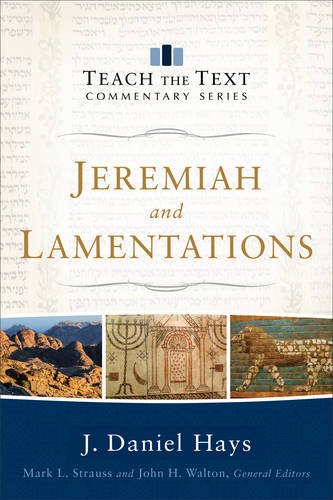Reviewed by Eric Tully
Readers have a dizzying array of options when it comes to choosing commentaries on books of the Bible. There are technical, non-technical, expository, devotional, conservative, moderate, critical, background, theological, women’s….and the list goes on. Each series has a goal and a particular audience in mind. The Teach the Text Commentary Series, of which the present volume is a part, is aimed at pastors and teachers in the church. The introduction states that it is intended to fill a gap between two kinds of commentaries which do not typically serve pastors well. The first is the technical commentary which is often overwhelming in details and contains tangential information. The second is the devotional commentary which may contain exegetical weaknesses and misuse Greek and Hebrew. The authors in the series seek “to provide a ready reference for the exposition of the biblical text, giving easy access to information that a pastor needs to communicate the text effectively (ix).
I highly recommend this commentary by Hays on Jeremiah/Lamentations. It is exegetically sophisticated, appropriately selective, and insightful in its discussion of contemporary relevance and application. J. Daniel Hays is dean of the School of Christian Studies and professor of biblical studies at Ouachita Baptist University in Arkadelphia.
As its title indicates, the volume addresses Jeremiah and Lamentations. The commentaries on each book begin with a brief introduction, five and three pages respectively which explain the authorship, historical setting, central message and purpose, and literary features. These issues help orient the reader to the distinctives of the book before moving directly into the commentary proper on the first chapter.
The book of Jeremiah is divided into 51 pericopes, and Lamentations into five pericopes. The discussion on each pericope follows the same format:
- Big Idea – This is the central “thesis statement” or main point of the passage
- Key Themes – These are the key ideas in the passage, presented in bullet points
- Understanding the Text – Here Hays locates the pericope in the context, often reviewing the main ideas in the preceding section which inform the present one. This is extremely helpful in a complex book like Jeremiah. He then addresses key issues of historical and cultural background before explaining select words, concepts, metaphors, or other exegetical issues in each verse. This is the actual commentary on the passage. It is highly selective, sometimes involving only one observation per verse. This section concludes with the authors theological insights, in which he moves from textual details to meaning.
- Teaching the Text – This brief section addresses the ways in which the meaning of the pericope is relevant for the contemporary reader. Sometimes Hays describes a common way that a pericope is misunderstood and then gently corrects it and explains the correct meaning in context.
- Illustrating the Text – In the final section, Hays suggests two to three illustrations that might be used in preaching or teaching. These include film clips, cultural trivia, significant books, visual aids, personal stories and other examples in Scripture. Most of these are creative and demonstrate pastoral sensitivity and a clear desire to communicate. A few are somewhat silly or unrealistic. For example, Hays suggests mixing dough for cookies on stage with a helper reading the recipe, but the preacher puts in too many eggs or adds gummy bears. Then someone in the audience should correct the preacher for not doing the recipe “justice” (154). One wonders if the time and setup required for such an illustration is worth the payoff.
Readers will not only learn much about the books of Jeremiah and Lamentations, but they will learn how to preach and teach by observing the ways that Hays highlights those details which are relevant for the main point, then moves from the main point to the theological meaning, and then to contemporary application.
I have two primary concerns about this kind of commentary. First, because it is by its very nature selective and guides the reader in getting to the main point, the preacher is not really forced to wrestle with the details of the passage. In my view, sermons should arise out of a great deal of prayer, thought, struggle, and preparation. The preacher has the opportunity to work through the text, bring all of the details together and draw a conclusion about the main point. The final sermon might contain 20% of all that the preacher studied. But this commentary is selective on behalf of the reader and so might present a kind of short-cut.
A second concern is that a preacher ideally brings the text to bear on a particular people in a particular context. He knows them, cries with them, hears their confessions and uses the preaching event as an opportunity for ongoing discipleship. But application commentaries might short-circuit this by providing an overly general application.
These concerns are not a critique of the present work, only a description of the inherent pros and cons of the type of commentary that it seeks to be. Hays has produced an outstanding volume within the objective of the series.
Hays has a thoroughly orthodox view of Scripture. He really follows what the text teaches: he does not try to soften or excuse it, but contextualizes it theologically. The connections he makes to culture and worldview issues is excellent. He handles the relationship of these OT texts to the NT in just the right way, not overriding the OT message, but thoroughly relating the text to the Christian. I found the book to be personally challenging and devotionally enriching.
This work on Jeremiah and Lamentations is highly recommended for pastors (not as a main commentary but as a check in late stages of preparation), Bible study teachers, and for personal Bible study.
Eric J. Tully is Associate Professor of Old Testament and Semitic Languages at Trinity Evangelical Divinity School in Deerfield, Illinois.
